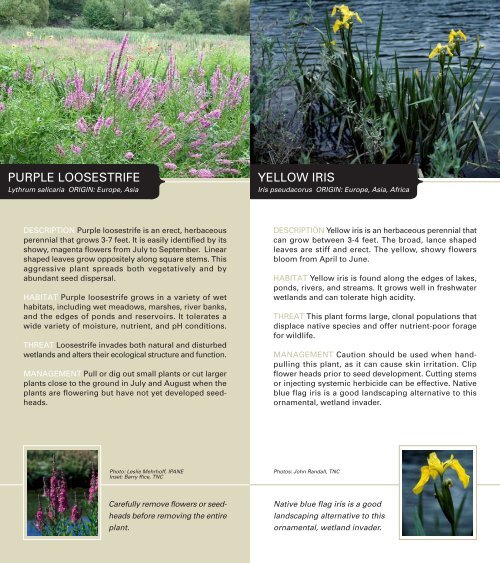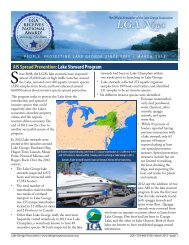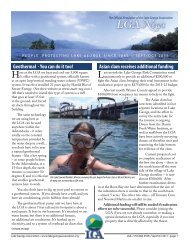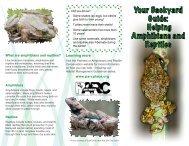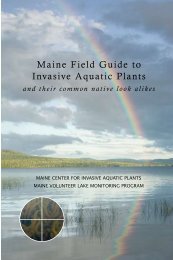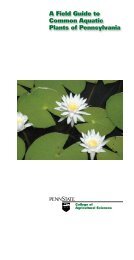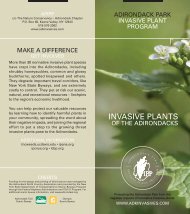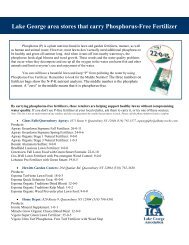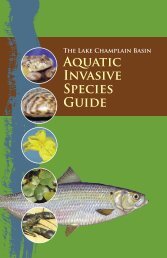Invasive Plants of the Adirondacks - Adirondack Park Invasive Plant ...
Invasive Plants of the Adirondacks - Adirondack Park Invasive Plant ...
Invasive Plants of the Adirondacks - Adirondack Park Invasive Plant ...
Create successful ePaper yourself
Turn your PDF publications into a flip-book with our unique Google optimized e-Paper software.
PURPLE LOOSESTRIFE<br />
Lythrum salicaria ORIGIN: Europe, Asia<br />
YELLOW IRIS<br />
Iris pseudacorus ORIGIN: Europe, Asia, Africa<br />
DESCRIPTION Purple loosestrife is an erect, herbaceous<br />
perennial that grows 3-7 feet. It is easily identified by its<br />
showy, magenta flowers from July to September. Linear<br />
shaped leaves grow oppositely along square stems. This<br />
aggressive plant spreads both vegetatively and by<br />
abundant seed dispersal.<br />
HABITAT Purple loosestrife grows in a variety <strong>of</strong> wet<br />
habitats, including wet meadows, marshes, river banks,<br />
and <strong>the</strong> edges <strong>of</strong> ponds and reservoirs. It tolerates a<br />
wide variety <strong>of</strong> moisture, nutrient, and pH conditions.<br />
THREAT Loosestrife invades both natural and disturbed<br />
wetlands and alters <strong>the</strong>ir ecological structure and function.<br />
MANAGEMENT Pull or dig out small plants or cut larger<br />
plants close to <strong>the</strong> ground in July and August when <strong>the</strong><br />
plants are flowering but have not yet developed seedheads.<br />
DESCRIPTION Yellow iris is an herbaceous perennial that<br />
can grow between 3-4 feet. The broad, lance shaped<br />
leaves are stiff and erect. The yellow, showy flowers<br />
bloom from April to June.<br />
HABITAT Yellow iris is found along <strong>the</strong> edges <strong>of</strong> lakes,<br />
ponds, rivers, and streams. It grows well in freshwater<br />
wetlands and can tolerate high acidity.<br />
THREAT This plant forms large, clonal populations that<br />
displace native species and <strong>of</strong>fer nutrient-poor forage<br />
for wildlife.<br />
MANAGEMENT Caution should be used when handpulling<br />
this plant, as it can cause skin irritation. Clip<br />
flower heads prior to seed development. Cutting stems<br />
or injecting systemic herbicide can be effective. Native<br />
blue flag iris is a good landscaping alternative to this<br />
ornamental, wetland invader.<br />
Photo: Leslie Mehrh<strong>of</strong>f, IPANE<br />
Inset: Barry Rice, TNC<br />
Photos: John Randall, TNC<br />
Carefully remove flowers or seedheads<br />
before removing <strong>the</strong> entire<br />
plant.<br />
Native blue flag iris is a good<br />
landscaping alternative to this<br />
ornamental, wetland invader.


